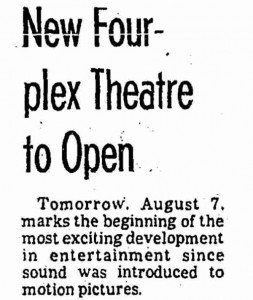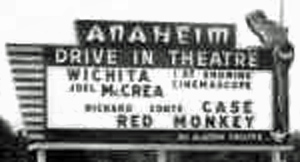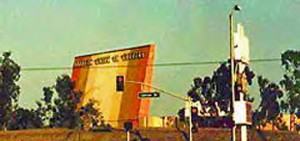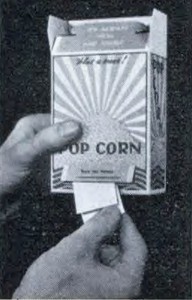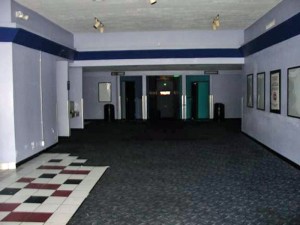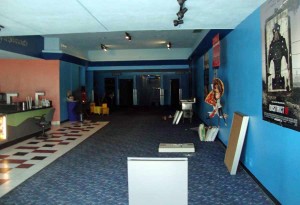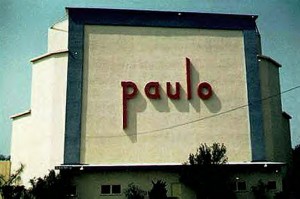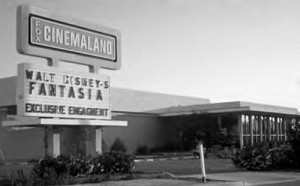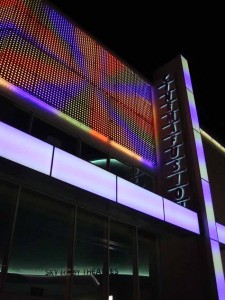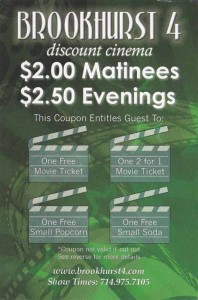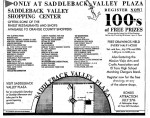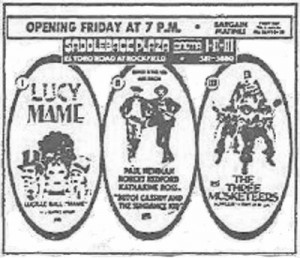Tags: 1 Comment
The Westminister 4: Brace Yourself For…Disappointment
August 8th, 2009 by
Respond
A Unique Postscript: The Anaheim Drive-In
August 5th, 2009 by
Respond
Fifty four years ago this week, Orange County welcomed it’s fifth ozoner with the grand opening of the Anaheim Drive-In. Once billed as “Orange County’s most luxurious super drive-in theatre”, the venue had a thirty-five year run, before closing in the spring of 1990. The Anaheim Drive-In also had a rather unique after life, being the site of one of the county’s more notable failed “lifestyle center” projects.
A few years after closing the drive-in, Pacific Theatres announced plans for a 26 screen megaplex and entertainment complex to be built on the property by the spring of 1997. In addition to the 100,000 square foot cinema, the plan called for ten restaurants and stores, a 30,000 square foot video game arcade, and 2,300 parking spaces; all set within a design that was to be modeled after Newport Beach’s Fashion Island shopping center (complete with “playful” fountains). At the time, the theatre would have been among the largest in the country.
Work on the proposed center began in July of 1996, with a VIP screen demolition ceremony that included local politicians and Pacific executives in attendance. Over the ensuing weeks, the lot was graded and a “coming soon” message was posted on the old drive-in marquee. However, by the end of the Summer, work came to an end almost as quickly as it has begun. Without explanation or an official announcement, the project was abandoned; the lone acknowledgement being the removal of the marquee message.
Rumors around the planned center’s demise have generally centered on AMC’s quick ten screen expansion of their neighboring Fullerton 10 theatre, in 1997. Yet, considering the potential drawing power of a full entertainment complex and new megaplex, one must question how the halfhearted expansion of an aging multiplex would have threatened Pacific out of a venture they had already committed considerable means in to launching. A second, less circulated rumor, involving a lack of financing, seems a more likely explanation. In any case, the lot sat empty for a few more years, before being sold and redeveloped in to a generic retail park; anchored by a hardware store and health club, rather than a cinema.
Tags: Comments Off on A Unique Postscript: The Anaheim Drive-In
Failed & Forgotten Concession Novelty
August 4th, 2009 by
Respond
Back in 1939, inventor Aston Moore proposed a new popcorn container for moviegoers, which added the convenience of a built in napkin dispenser. Similar to a cereal box, the cardboard container was lined with a wax paper bag for the popcorn; the napkin was housed below the bag and accessed via a small slit in the box. There is no evidence Mr. Moore’s invention was ever implemented to any significant extent (if at all); likely reflective of the increased manufacturing costs involved with the concept.
Tags: Comments Off on Failed & Forgotten Concession Novelty
Another Brookhurst Theatre Update
July 31st, 2009 by
Respond
While still no news to report on the Brookhurst’s long delayed reopening (a sign in the window states “soon”), I did manage to stop by and take a few pictures. Here are some before and after shots to gauge how much work is being done:
.
If nothing else, the concession stand appears to have recieved a substantial, and long overdue, upgrade. One can only hope the auditoriums have garnered as much attention.
Tags: 1 Comment
Costa Mesa’s Paulo Drive-In
July 31st, 2009 by
Respond
Tags: 5 Comments
Balto in Anaheim
July 26th, 2009 by
Respond
Tags: Comments Off on Balto in Anaheim
Hollywood In Fullerton Night
July 20th, 2009 by
Respond
The 6th annual “Hollywood in Fullerton” night (held on June 27th) proved to be a success, attracting roughly six hundred people and raising an estimated $40,000 for the Fox Fullerton. Perhaps, the hi light of the evening was a 70’s theme stage show, which market the theatre’s first live stage performance in some fifty years.
Due to the building’s current condition, the audience was required to don hard hats, but even reaching the point, when a large event can be held in the theatre, was a significant milestone in the Fox’s rebirth.
Tags: Comments Off on Hollywood In Fullerton Night
The Not So Magic Kingdom
July 19th, 2009 by
Respond
Tags: 1 Comment
Brookhurst Reopening Update
July 16th, 2009 by
Respond
Tags: Comments Off on Brookhurst Reopening Update
Forgotten Cinema: Saddleback 1-2-3
July 13th, 2009 by
Respond
Tags: Comments Off on Forgotten Cinema: Saddleback 1-2-3

